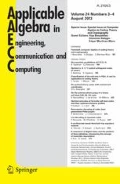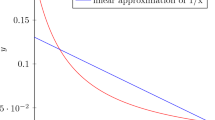Abstract
Climent et al. (Appl Algebra Eng Commun Comput 22:91–108, 2011) identified the elements of the endomorphisms ring End\({(\mathbb{Z}_p \times \mathbb{Z}_{p^2})}\) with elements in a set, E p , of matrices of size 2 × 2, whose elements in the first row belong to \({\mathbb{Z}_{p}}\) and the elements in the second row belong to \({\mathbb{Z}_{p^2}}\). By taking advantage of matrix arithmetic, they proposed a key exchange protocol using polynomial functions over E p defined by polynomials in \({\mathbb{Z}[X]}\). In this note, we show that this protocol is insecure; it can be broken by solving a set of 10 consistent homogeneous linear equations in 8 unknowns over \({\mathbb{Z}_{p^2}}\).
Similar content being viewed by others
References
Climent J.J., Navarro P.R., Tortosa L.: On the arithmetic of the endomorphisms ring \({End(\mathbb{Z}_p \times Z_p^2)}\). Appl. Algebra Eng. Commun. Comput. 22, 91–108 (2011)
Bergman G.M.: Examples in PI ring theory. Israel J. Math. 18, 257–277 (1974)
Myasnikov A., Shpilrain V., Ushakov A.: Non-Commutative Cryptography and Complexity of Group-Theoretic Problems in Mathematical, Surveys and Monographs. Vol. 177, American Mathematical Society, Providence (2011)
Tsaban, B.: Combinatorial Group Theory and Cryptography Bulletin (CGC Bulletin). http://u.cs.biu.ac.il/~tsaban/CGC/cgc.html
Stickel, E.: A new method for exchanging secret keys. In: Proceedings of the thrid International Conference on Information Technology and Applications (ICITA’05), pp. 426–430. Sidney (2005)
Shpilrain, V.: Cryptanalysis of Stickel’s key exchange scheme. In: Computer Science in Russia-CSR’08, Lecture Notes in Computer Science, vol. 5010, pp. 283–288. Springer, Berlin (2008)
Sramka M.: On the security of Stickel’s key exchange scheme. Comb. Math. Comb. Comput. 66, 151–159 (2008)
Mullan C.: Cryptanalysing variants of Stickel’s key agreement protocol. Math. Crypt. 4(4), 365–373 (2011)
Mullan, C.: Some Results in Group-Based Cryptography, Thesis submitted to the University of London for the Degree of Doctor of Philosophy (2011)
Cha, J.C., Ko, K.H., Lee, S., Han, J.W., Cheon, J.H.: An efficient implementation of braid groups. In: Advances in Cryptology-ASIACRYPT’01, Lecture Notes in Computer Science, vol. 2248, pp. 144–156. Springer, Berlin (2001)
Ko K.H., Lee S., Cheon J.H., Han J.W., Kang J.S., Park C.: New public-key cryptosystem using braid groups. In: Bellare, M. (ed.) Advances in Cryptology-CRYPTO’00, Lecture Notes in Computer Science, vol. 1880, pp. 166–183. Springer, Berlin (2000)
Hughes, J.: A linear algebraic attack on the AAFG1 braid group cryptosystem. In: Australian Conference on Information Security and Privacy-ACISP’02, Lecture Notes in Computer Science, vol. 2384, pp. 176–189. Springer, Berlin (2002)
Cheon, J.H., Jun, B.: A Polynomial Time Algorithm for the Braid Diffie-Hellman Conjugacy Problem. In: Advances in Cryptology-CRYPTO’03, Lecture Notes in Computer Science, vol. 2729, pp. 212–225. Springer, Berlin (2003)
Lee, E., Park, J.H.: Cryptanalysis of the public-key encryption based on braid groups. In: Advances in cryptology-EUROCRYPT’03, Lecture Notes in Computer Science, vol. 2656, pp. 477–490. Springer, Berlin (2003)
Kalka A.G.: Representation attacks on the braid Diffie-Hellman public key encryption. Appl. Algebra Eng. Commun. Comput. 17, 257–266 (2006)
Author information
Authors and Affiliations
Corresponding author
Rights and permissions
About this article
Cite this article
Kamal, A.A., Youssef, A.M. Cryptanalysis of a key exchange protocol based on the endomorphisms ring End\({(\mathbb{Z}_{p} \times \mathbb{Z}_{p^2})}\) . AAECC 23, 143–149 (2012). https://doi.org/10.1007/s00200-012-0170-z
Received:
Revised:
Accepted:
Published:
Issue Date:
DOI: https://doi.org/10.1007/s00200-012-0170-z




